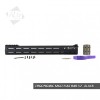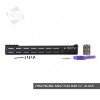If you are worried about a friction-fit rail slipping on the barrel nut, look at the ALG free-float rail. It is a little more of a complicated install, but when finished, it is more solid than any other rail I have used. The rail bolts directly on to the custom barrel nut. With 6 screws.
Not to say my MI can be moved easily, but the ALG is almost overbuilt. It ain't moving. I am using a carry handle and non-folding front rail-mounted sights on a 15" rail. Much more accurate than it was with the original sights set at carbine length. Once again, this is due to the sight radius more than the sights themselves.




